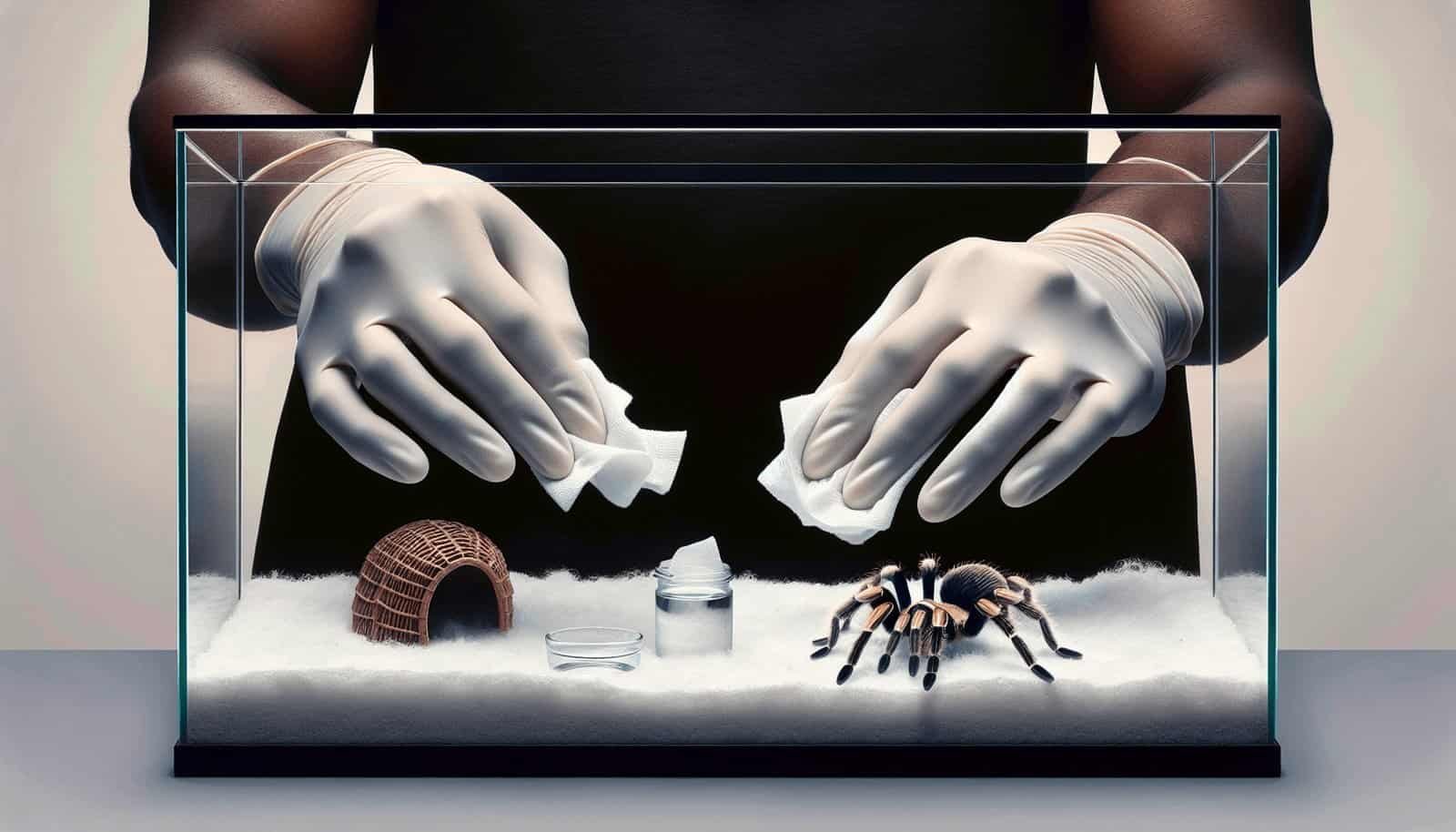So, you’ve recently become the proud owner of a tarantula and now you’re faced with the important task of cleaning and disinfecting its enclosure. Don’t worry, we’ve got you covered! In this article, we’ll guide you through the simple steps to ensure your tarantula’s home stays clean and hygienic. From choosing the right cleaning supplies to maintaining a proper cleaning routine, you’ll learn everything you need to know to keep your eight-legged friend happy and healthy. Let’s get started!

Preparing for Cleaning
Cleaning and disinfecting your tarantula’s enclosure is an important part of maintaining their health and well-being. Before you begin the cleaning process, it’s essential to gather the necessary supplies and ensure necessary safety measures are in place.
Gather Necessary Supplies
To effectively clean your tarantula’s enclosure, you will need specific supplies. Here’s a list of items you will need:
- A temporary container for your tarantula
- Warm water
- Vinegar solution (equal parts vinegar and water)
- Clean cloths or paper towels
- Disinfectant solution suitable for reptile enclosures
- New substrate for the enclosure
- Clean water dish and food bowl
- Soft-bristled brush for scrubbing
Having all the supplies ready before you start cleaning will make the process smoother and more efficient.
Ensure Safety Measures
While handling your tarantula’s enclosure, it’s crucial to prioritize safety for both yourself and your spider. Here are a few safety measures to keep in mind:
- Wear protective gloves to avoid direct contact with your tarantula or any potential contaminants.
- Make sure the work area is well-ventilated to minimize exposure to any cleaning fumes.
- Avoid using harsh chemicals or abrasive cleaners that could harm your tarantula. Stick to reptile-safe products.
- Take precautions to prevent any potential escapes during the cleaning process. It’s best to work in a room with closed doors and windows or use a large, escape-proof container for your tarantula.
By following these safety measures, you can ensure a safe and effective cleaning process for both you and your tarantula.
Emptying the Tarantula Enclosure
Before you can start cleaning the enclosure, you’ll need to remove your tarantula safely and transfer it to a temporary container. Here’s how:
Remove Tarantula
Gently and carefully coax your tarantula out of its enclosure using a soft brush or a clean, long-handled instrument. It’s essential to be patient and gentle during this process to avoid stressing or harming your spider. If your tarantula is unwilling to move, you can try using a piece of cardboard or a clear plastic cup to encourage it to climb onto it. Remember to move slowly and avoid sudden movements.
Transfer Tarantula to Temporary Container
Once your tarantula is safely out of the enclosure, carefully place it in a secure and appropriately sized temporary container. Ensure that the container has adequate ventilation, such as small air holes or a mesh lid, and is escape-proof. Fill the container with a small amount of substrate to provide a familiar and comfortable environment for your tarantula during the cleaning process.
By carefully removing and transferring your tarantula to a temporary container, you create a safe environment for both the spider and yourself while cleaning the enclosure.

Cleaning the Enclosure
Now that the tarantula has been safely relocated, you can proceed with cleaning the enclosure. Properly cleaning the enclosure helps maintain a hygienic and healthy environment for your tarantula. Follow these steps:
Remove Substrate and Decorations
Start by emptying the enclosure of all the substrate and decorations. Using a clean, dry cloth or a suitable tool, carefully remove any excess substrate, including leftover food or waste. Dispose of the substrate in a proper waste bag or container.
Next, remove any decorations such as artificial plants, rocks, or hiding spots. Clean them separately using the methods mentioned later in the article.
Wash with Warm Water
Once the substrate and decorations have been removed, wash the enclosure with warm water. Gently scrub the interior walls and floor using a soft cloth or sponge. You can also use a soft-bristled brush for harder-to-reach areas or stubborn dirt. Be thorough but careful to avoid damaging the enclosure.
Use Vinegar Solution for Deep Cleaning
For a deeper clean, mix equal parts vinegar and water to create a vinegar solution. Vinegar is a safe and effective natural cleaner that helps eliminate bacteria and fungal growth. Dampen a clean cloth or sponge with the vinegar solution, and gently wipe down the interior of the enclosure. Pay special attention to any areas that show signs of contamination or buildup. Vinegar’s acidic properties help break down organic matter and remove any residual odors.
Disinfecting the Enclosure
After the cleaning process is complete, it’s crucial to disinfect the enclosure to eliminate any potential pathogens or parasites. Here’s how to ensure proper disinfection:
Prepare a Disinfectant Solution
Select a reptile-safe disinfectant solution specifically designed for enclosures. Follow the manufacturer’s instructions to prepare the solution in a clean container. Avoid using household disinfectants, as they may contain harmful chemicals that could be toxic to your tarantula.
Wipe Down Enclosure with Disinfectant
Dampen a clean cloth or sponge with the prepared disinfectant solution. Thoroughly wipe down the walls, floor, and any other surfaces inside the enclosure. Ensure complete coverage while avoiding excessive saturation. Pay extra attention to areas that may have been heavily soiled or contaminated.
Allow to Air Dry
After disinfecting the enclosure, it’s essential to let it air dry completely. Placing the enclosure in direct sunlight or using a fan can help expedite the drying process. Avoid reintroducing your tarantula until the enclosure is completely dry to prevent any potential harm or irritation.

Cleaning Accessories
In addition to cleaning and disinfecting the enclosure, it’s crucial to pay attention to the accessories within it. Here are some important steps to follow:
Clean Water Dish and Food Bowl
Remove the water dish and food bowl from the enclosure. Empty any leftover water or food, and rinse them thoroughly with warm water. Use a clean cloth or sponge to wipe away any residue or contaminants. If necessary, use a reptile-safe disinfectant solution to sanitize the dishes, but be sure to rinse them thoroughly afterward to avoid any chemical residue.
Wash and Disinfect Decorations
The decorations in your tarantula’s enclosure may accumulate dust, dirt, or other contaminants over time. To clean them, follow these steps:
-
Artificial Plants: Gently rinse the plants under warm running water to remove any debris or dust. If they require deeper cleaning, you can use a solution of warm water and reptile-safe disinfectant. Rinse thoroughly and allow them to air dry completely before putting them back in the enclosure.
-
Rocks and Hiding Spots: Scrub the rocks and hiding spots with warm water and a soft-bristled brush to remove any dirt or residue. You can also use a reptile-safe disinfectant solution for a more thorough clean. Rinse them well and allow them to air dry before placing them back in the enclosure.
Taking the time to clean and sanitize the accessories ensures a clean and safe environment for your tarantula to thrive in.
Reassembling the Enclosure
After the cleaning and disinfection processes are complete, it’s time to reassemble the tarantula’s enclosure. Follow these steps to ensure a comfortable and inviting living space for your spider:
Add Fresh Substrate
Choose a suitable substrate for your tarantula based on their species and specific habitat requirements. Carefully add a sufficient layer of substrate to the floor of the enclosure, ensuring a depth that allows for burrowing and provides ample space for your tarantula to move around comfortably.
Put Back Decorations
Place the cleaned and dried decorations back into the enclosure. Arrange them in a way that creates hiding spots and climbing opportunities for your tarantula. Consider their natural habitat and behavioral preferences when arranging the decorations to simulate a more natural and engaging environment.
Return Tarantula to Clean Enclosure
Finally, it’s time to reintroduce your tarantula to its freshly cleaned and reassembled enclosure. Gently transfer your tarantula from the temporary container back into its clean enclosure. Allow the tarantula some time to acclimate to their environment before interacting with them.
By reassembling the enclosure in a thoughtful and engaging manner, you create a stimulating and comfortable home for your tarantula.

Regular Maintenance
After the initial cleaning and reassembly, it’s important to incorporate regular maintenance routines to keep your tarantula’s enclosure clean and safe. Here are some essential steps:
Spot Clean as Needed
Regularly monitor the enclosure for any signs of contamination or waste buildup. Remove any visible waste promptly using a clean cloth or sponge. Regular spot cleaning prevents the accumulation of potentially harmful bacteria or parasites and ensures a hygienic environment for your tarantula.
Perform Monthly Deep Cleanings
In addition to spot cleaning, perform a more thorough cleaning and disinfection of the enclosure at least once a month. This routine maintenance helps minimize the risk of contamination and keeps your tarantula’s habitat clean and healthy. Follow the steps outlined earlier in this article for an effective monthly deep cleaning.
Monitor Enclosure for Signs of Contamination
Keep a close eye on your tarantula’s behavior and monitor the enclosure for any signs of contamination or illness. If your tarantula displays unusual behavior, such as decreased appetite, lethargy, or abnormal webbing patterns, it could indicate a potential problem. In such cases, consulting with a veterinarian specializing in exotic pets is advised to ensure your tarantula receives appropriate care.
Maintaining regular maintenance and monitoring routines helps create a clean and healthy environment for your tarantula’s overall well-being.
In conclusion, cleaning and disinfecting a tarantula’s enclosure is essential for maintaining a safe and healthy environment for your beloved spider. By following these step-by-step instructions and incorporating regular maintenance routines, you can provide your tarantula with a clean and stimulating living space, promoting their overall health and happiness.
